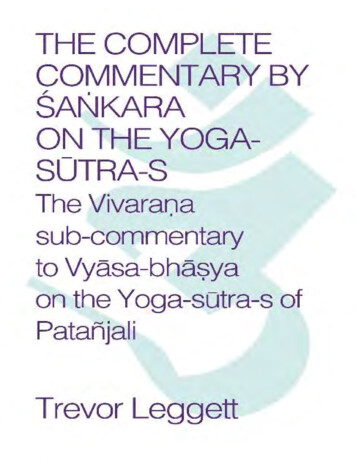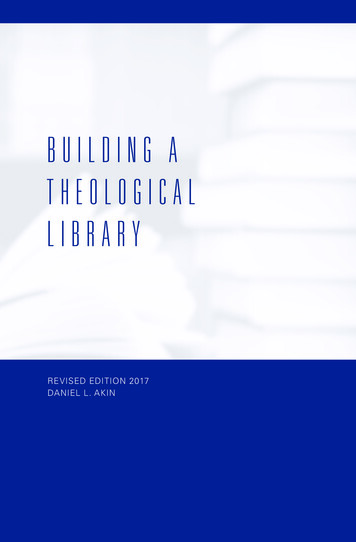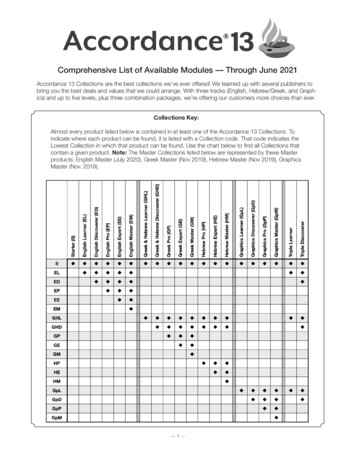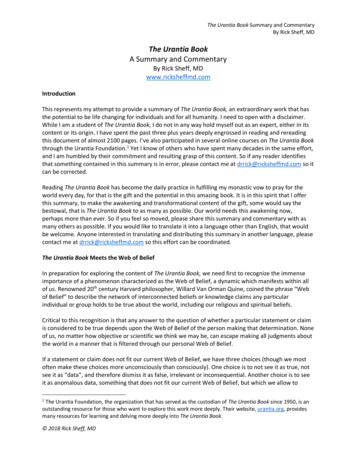
Transcription
Postal Address of the Trust:Trevor Leggett Adhyatma Yoga TrustPO Box 362KINGS LYNNPE31 8WQUnited KingdomWebsite address of the Trust:www.tlayt.orgCopyright 2016 Trevor Leggett Adhyatma Yoga TrustPrinted edition first published in 1990 by Kegan Paul International LtdAll rights reservedNo part of this publication may be reproduced or distributed in any form or by any means,or stored in a data base or retrieval system, without the prior written permission of thepublisher Trevor Leggett Adhyatma Yoga Trust, except for the quotation of brief passagesin criticism.Printed in the United KingdomISBN - 978-1-911467-04-5Trevor Leggett Adhyatma Yoga Trust
To the late Hari Prasad Shastri, pandit and jñani of India, translator ofŚaṅkara’s works and a faithful follower of Śaṅkara in his own originalworks, this translation is reverently dedicated
AcknowledgementsI am grateful to Dr. Hajime Nakamura, Professor Emeritus of the Universityof Tokyo and founder of the Eastern Institute, Tokyo, for help with thetranslation of the First Part. For errors that remain I am entirely responsible.The late Shankaracarya of Sringeri, H.H. Abhinava Vidyatirtha, showedmuch interest in this Vivaraṇa and encouraged the present translator totackle this difficult text, which (he said) might be of great importance in thestudy of Śaṅkara.The trustees of the Trevor Leggett Adhyatma Yoga Trust wish to expresstheir grateful thanks to Dr Kengo Harimoto of MahidolUniversity,Thailand, who kindly agreed to write a Foreword to this E-bookedition of The Complete Commentary by Śaṅkara on the Yoga Sutras,translated by Trevor Pryce Leggett. Dr Harimoto’s most valuable andinteresting Foreword reviews and puts in context some of the commentsthat have been made on the author’s translation since it was first publishedin London in 1990 and also on the authenticity of the Vivaraṇa as a work byŚaṅkara.
ContentsForeword by Kengo HarimotoIntroduction for the general readerHow to use this Book for Yoga PracticeTechnical introductionFIRST PART: SAMĀDHI1 Yoga theorySūtra I.1 Now the exposition of yogaSūtra I.2 Yoga is inhibition of the mental processesSūtra I.3 Then the Seer is established in his own natureSūtra I.4 Otherwise, it conforms itself to the mental process2 Mental processesSūtra I.5 The mental processes are of five kinds; they are tainted or pureSūtra I.6 Right knowledge, illusion, logical construction, sleep, memorySūtra I.7 Right knowledge is either direct perception, inference, orauthoritySūtra I.8 Illusion is false knowledge based on an untrue formSūtra I.9 Logical construction is something that follows verbal knowledgebut has no real objectSūtra I.10 The mental process which rests on the notion of non-existenceis sleepSūtra I.11 Memory is not letting slip away an object experienced
3 PracticeSūtra I.12 Their inhibition is by practice and detachmentSūtra I.13 Practice is the effort at steadiness in itSūtra I.14 But practised for a long time, uninterruptedly and withreverence, it becomes firmly groundedSūtra I.15 Detachment is consciousness of self-mastery, of one who has nothirst for any object either seen or heard aboutSūtra I.16 It is the higher detachment when from knowledge of Puruṣathere is no thirst for (even) the guṇa-s4 SamādhiSūtra I.17 It is cognitive because accompanied with verbal associations(vitarka), with subtle associations (vicāra), with joy (ānanda), andthe form of I-am-ness (asmitā)Sūtra I.18 The other (samādhi) follows on practice of the idea of stopping,and consists of saṃskāra-s aloneSūtra I.19 It results from birth in the case of gods discarnate, and in thecase of those who absorb themselves into prakṛtiSūtra I.20 For the others, it comes after faith, energy, memory, (cognitive)samādhi, and knowledgeSūtra I.21 For those who practise with ardent energy, it is nearSūtra I.22 Even among the ardent, there is a distinction of mild ormoderate or intense5 GodSūtra I.23 Or by special devotion to the LordSūtra I.24 Untouched by taints or karma-s or their fruition or their latentstocks is the Lord, who is a special kind of PuruṣaSūtra I.25 In whom the seed of omniscience becomes transcendentSūtra I.26 The teacher of even the first teachers, because not particularizedby timeSūtra I.27 Of him, the expression is praṇava (OM)Sūtra I.28 Repetition of it and meditation on its meaning
6 ObstaclesSūtra I.29 From that, realization of the separate consciousness, andabsence of obstaclesSūtra I.30 Illness, apathy, doubt, carelessness, laziness, failure towithdraw, misconceptions, failure to attain a state, instability (inthe state) – these distractions of the mind are the obstaclesSūtra I.31 Pain, frustration, restlessness of the body, spasmodic breathingin or out are the accompaniments of these distractionsSūtra I.32 To prevent them, practice on one principle7 Special PracticesSūtra I.33 The mind is made clear by meditation on friendliness towardsthe happy, compassion for the suffering, goodwill towards thevirtuous, and disinterest in the sinfulSūtra I.34 Or by expulsion and retention of prāṇaSūtra I.35 Or achievement of supernormal perception of a divine objectbrings the mind to steadinessSūtra I.36 Or a radiant perception beyond sorrowSūtra I.37 Or on a mind whose meditation is on freedom from passionSūtra I.38 Or meditating on the knowledge of dream and sleepSūtra I.39 Or by meditation on what appeals to himSūtra I.40 His mastery extends right to the ultimate atom and to theultimate magnitude8 AbsorptionSūtra I.41 Identification-in-samādhi (samāpatti) is when the mentalprocess has dwindled and the mind rests on either the knower orthe knowing process or a known object, and like a crystalapparently takes on their respective qualitiesSūtra I.42 The samādhi-identification is called sa-vitarka when it is mixedup with mental constructs of word, thing and ideaSūtra I.43 When there is purification from memories, (that samādhi)apparently empty of its own nature of knowledge, with the object
alone shining forth, is nir-vitarkaSūtra I.44 In the same way, when it is on subtle objects, it is calledsavicāra (with subtle associations) and nir-vicāra (without subtleassociations)Sūtra I.45 The scale of (causal) subtlety of objects ends in pradhānaSūtra I.46 These are samādhi from-a-seedSūtra I.47 From skill in nir-vicāra, a clearness in the selfSūtra I.48 In this, the knowledge is Truth-bearingSūtra I.49 This knowledge is of a particular thing, unlike knowledge fromauthority or from inferenceSūtra I.50 The saṃskāra produced by it inhibits other saṃskāra-sSūtra I.51 When that too is inhibited, everything is inhibited, and thus thissamādhi is without-seedSECOND PART: MEANS1 Yoga of actionSūtra II.1 Tapas, self-study, devotion to the Lord, are the yoga of actionSūtra II.2 To actualize samādhi and thin out the taints2 TaintsSūtra II.3 Ignorance, I-am-ness, desire, hate, instinctive self-preservation,are the taintsSūtra II.4 Ignorance is the field of germination of the subsequent ones,whether dormant or thinned out or checked or activeSūtra II.5 Ignorance is the conviction of permanence, purity, happiness andself in what are really impermanent, impure, painful and not selfSūtra II.6 The single selfhood, as it were, of the powers of seer and seeingis I-am-nessSūtra II.7 Desire follows on pleasureSūtra II.8 Hate follows on painSūtra II.9 With spontaneous momentum, instinctive even in a Knower, isself-preservation
Sūtra II.10 In their subtle state, they are to be got rid of by dissolution intheir sourceSūtra II.11 Mental processes arising from them are got rid of bymeditation3 KarmaSūtra II.12 Rooted in taints is the karma-stock to be felt in present orfuture livesSūtra II.13 While the root is there, it will bear the fruit of birth, life spanand experienceSūtra II.14 Their fruits are joy and suffering caused by virtue and sin4 PainSūtra II.15 Because of the sufferings caused by changes and anxieties andthe saṃskāra-s of them, and from the clash of the guṇa-s, to theclear-sighted, everything is pain alone5 Guṇa-s6 ReleaseSūtra II.16 What is to be escaped is the pain not yet comeSūtra II.17 The Seer-Seen conjunction is the cause of what is to be escaped7 Guṇa-s againSūtra II.18 With a constant tendency towards light, action, and fixity, theSeen consists of the elements and the senses, being for the purposeof experience and transcendenceSūtra II.19 What particularizes itself, and what does not, what goes (liṅga,the Great principle) and what does not (a-liṅga, pradhāna), areguṇa-implementers
8 PuruṣaSūtra II.20 The Seer is sight alone; though pure, he looks on at thethoughtsSūtra II.21 The essence of the Seen is to be for the purpose of him alone9 Seer-SeenSūtra II.22 For one whose purpose has been effected, it is ended, but notfor others, because it is commonSūtra II.23 The conjunction causes awareness of the natures of the twopowers, the property and its possessorSūtra II.24 Its cause is Ignorance (a-vidyā)Sūtra II.25 Without it, there is no conjunction, and that release isTranscendental Aloneness (kaivalya) of the power-of-sight10 Release againSūtra II.26 Unwavering Knowledge-of-the-difference is the means ofreleaseSūtra II.27 Therein, the ultimate state of the Knowledge is seven-fold11 YogaSūtra II.28 From following up the methods of yoga, destruction ofimpurity and a growing light of knowledge up to Knowledge-ofthe-differenceSūtra II.29 Restraints, observances, posture, restraint of vital currents,dissociation, concentration, meditation, samādhi are the eightmethods12 RestraintsSūtra II.30 Of these, harmlessness, truth-speaking, no stealing,brahmacarya, not holding possessions, are the restraintsSūtra II.31 When practised universally without qualification of birth,place, time, or obligation, they are called the Great Vow
13 ObservancesSūtra II.32 Purity, contentment, tapas, self-study, and devotion to the Lordare the observances14 Contrary ideasSūtra II.33 If there is obstruction by contrary ideas, meditation on theiroppositeSūtra II.34 The contrary ideas, violence and the others, done or caused tobe done or approved of, preceded by greed, anger or delusion,mild, medium, or intense – all result in endless pain and Ignorance.This is the meditation on their opposite15 PerfectionsSūtra II.35 With establishment of harmlessness, in his presence enmity isabandonedSūtra II.36 With establishment of truth, events confirm his wordsSūtra II.37 With establishment in non-stealing, all precious things come tohimSūtra II.38 With establishment in brahmacarya, attainment of energySūtra II.39 With firmness in not possessing property, clear knowledge ofthe conditions of birthSūtra II.40 From purity, distaste for his own body and no intercourse withothersSūtra II.41 Purity of mind-sattva, cheerfulness, one-pointedness, conquestof the senses, and fitness for vision of the selfSūtra II.42 From contentment, attainment of unsurpassed happinessSūtra II.43 From destruction of impurity by tapas, perfection of body andsensesSūtra II.44 From self-study, communion with the deity of his devotionSūtra II.45 From devotion to the Lord, perfection in samādhi16 Controls
Sūtra II.46 Posture is to be firm and pleasantSūtra II.47 By relaxing effort and by samādhi (samāpatti) on infinitySūtra II.48 From that, he becomes immune to the oppositesSūtra II.49 Prāṇāyāma is to sit in the posture and cut off the flow of inbreath and out-breathSūtra II.50 The external, internal, and fixating operations, practised interms of place, of time and of number, become long and fineSūtra II.51 The fourth prāṇāyāma comes when both external and internalfields have been felt intoSūtra II.52 Thereby is destroyed the covering of the lightSūtra II.53 Fitness of the mind for concentrationsSūtra II.54 Dissociation is when the senses, disjoined from their respectiveobjects, assume as it were the nature of mind itselfSūtra II.55 From that, supreme mastery of the sensesTHIRD PART: GLORY1 Inner MethodsSūtra III.I Dhārāṇā is binding the mind to a placeSūtra III.2 Continuity of the mind there is dhyāna (meditation)Sūtra III.3 That same (meditation), when it comes to shine forth as theobject alone, apparently empty of its own nature as knowledge, iscalled samādhiSūtra III.4 The triad (held) at the one place is saṃyamaSūtra III.5 From mastery of that, the light of knowledge (prajñā)Sūtra III.6 Its application is by stagesSūtra III.7 Compared to the previous means, this triad is the direct meansSūtra III.8 Even that is an indirect means as regards unseeded (yoga)Sūtra III.9 The inhibitive transformation of the mind is when extravertivesaṃskāra is overcome and the saṃskāra of inhibition ispredominant, and mind itself is in a temporary state of inhibitionSūtra III.10 It has a peaceful flow, by reason of the saṃskāra-s
Sūtra III.11 The destruction of the mind’s dispersiveness, and rise of itsone-pointedness, is the samādhi transformationSūtra III.12 In that (samādhi) the sameness of the idea which has subsidedand the newly arisen idea in the mind is its transformation of onepointedness2 ChangeSūtra III.13 By (analogy with) that, are explained the transformations ofdharma, time-phase and basis (avasthā) in the elements and in thesensesSūtra III.14 What conforms to the subsided, uprisen and indeterminabledharma-s is the dharminSūtra III.15 Difference of sequence causes the differences of the changesSūtra III.16 From saṃyama on the three changes, knowledge of what ispast and future3 Meaning-flashSūtra III.17 There is confusion from the mutual projection of word,meaning and idea on to each other. From saṃyama on theirdistinctness (comes) understanding of the cries of all beings4 GloriesSūtra III.18 From direct perception of the saṃskāra-s, knowledge ofprevious livesSūtra III.19 (From direct perception through saṃyama) of his thought,knowledge of the mind of anotherSūtra III.20 But not the subject of those ideas, because that was not thefield of the saṃyamaSūtra III.21 From saṃyama on the form of the body, its potentiality ofbeing seen is nullified. Being disjoined from the light of the eye, itdisappearsSūtra III.22 Karma is rapid or slow. From saṃyama on it, or on omens,there comes foreknowledge of death
Sūtra III.23 (From saṃyama) on friendliness and the others (compassionand goodwill, sūtra I.33) (there arise) powersSūtra III.24 Powers like the power of an elephant (come from saṃyama)on themSūtra III.25 By projecting the light of supernormal radiant perception (I.36) on to what is subtle, hidden or remote, (he comes to)knowledge of thatSūtra III.26 From saṃyama on the sun, knowledge of the worldsSūtra III.27 (From saṃyama) on the moon, knowledge of the dispositionsof the starsSūtra III.28 (From saṃyama) on the Pole Star, knowledge of their motionsSūtra III.29 On the navel circle, knowledge of the plan of the bodySūtra III.30 At the pit of the throat, cessation of hunger and thirstSūtra III.31 On the tortoise nerve, rigid steadinessSūtra III.32 On the Light in the head, vision of the perfect onesSūtra III.33 By the prātibha supernormal knowledge too (he knows)everythingSūtra III.34 On the heart, awareness of the mind5 KnowledgeSūtra III.35 Experience is an idea which does not distinguish betweensattva and Puruṣa, though they are absolutely separate; bysaṃyama on what-is-for-its-own-sake, (distinct) from what-is-forthe-sake-of-another, there comes knowledge of PuruṣaSūtra III.36 From that arise supernormal knowledge and hearing, touch,sight, taste and awareness of eventsSūtra III.37 They are obstacles in samādhi, but perfections in theextravertive state6 Glories (continued)Sūtra III.38 From loosening of the cause of tying, and awareness of howthe mind moves, the mind can enter another body
Sūtra III.39 By mastering the upgoing vital current (udāna), he passesuntouched over water, mud, thorns and so on, and at death he takesthe upward courseSūtra III.40 From mastery of samāna, blazing lightSūtra III.41 From saṃyama on the relation between hearing and space,divine hearingSūtra III.42 From saṃyama on the relation between the body and space,followed by identification-in-samādhi (samāpatti) with thelightness of a thread, he travels through spaceSūtra III.43 The Great Bodiless is a mental process (vṛtti) functioningexterior (to the body), and not imaginary; from this comesdwindling away of the covering of the lightSūtra III.44 From saṃyama on their physical form, inherence andpurposefulness: conquest of the elementsSūtra III.45 From it (the saṃyama) manifest a set of eight powers likebecoming minute, and perfection of the body, with freedom fromimpediment for its (bodily) attributesSūtra III.46 The perfection of the body is grace, splendour, power anddiamond hardnessSūtra III.47 From saṃyama on their perception, essential nature, I-amness, inherence and purposefulness, (comes) conquest of the sensesSūtra III.48 From that, speediness as of the mind, independence ofphysical organs, and conquest of natureSūtra III.49 Having simply the knowledge that (mind-)sattva and Puruṣaare different, one has omnipotence over all beings and isomniscientSūtra III.50 From indifference to that too, the seeds of imperfection aredestroyed, and there is Transcendental AlonenessSūtra III.51 No reaction of attachment or pride in case of invitations fromrulers of celestial realms, for undesirable consequences follow7 OmniscienceSūtra III.52 From saṃyama on the instant, and on the two sequences ofinstants, comes knowledge-born-of-discrimination
Sūtra III.53 From this (knowledge) there is clear knowledge of two things(seemingly) equivalent because they cannot be distinguished byclass, characteristic or positionSūtra III.54 Knowledge-born-of-discrimination, having all, and all times,for its object, is called Transcendent8 Transcendental AlonenessSūtra III.55 When the (mind-)sattva is like Puruṣa in purity, there isTranscendental Aloneness. So it isFOURTH PART: TRANSCENDENTAL ALONENESS (KAIVALYA)I PerfectionsSūtra IV.1 Perfections (siddhi) arise from birth or from drugs or frommantra-s or from tapas or from samādhiSūtra IV.2 The transformation into another life is implemented by prakṛtiSūtra IV.3 That cause is not the impelling drive itself, but it makes abreach in the retaining barrier of the natures, as does a farmer (forirrigation)Sūtra IV.4 The minds are projected from bare I-am-nessSūtra IV.5 In the variety of activities, it is the one mind that impels theseveral mindsSūtra IV.6 Of those (minds with perfections), the mind whose perfectionsarise out of meditation (dhyāna) has no karma-stock2 KarmaSūtra IV.7 The karma of the yogin is neither white nor black; of the others,it is of three kindsSūtra IV.8 Therefore their consequent manifestation is of those saṃskāragroups (vāsanā) that are compatible with itSūtra IV.9 Because there is sameness of form of memory and saṃskāra-s,there is consequent succession between them, even thoughseparated by class and place and time
Sūtra IV.10 They are beginningless, because hope is eternalSūtra IV.11 They are held together by cause-effect-repository-focal-point.When these cease, they too ceaseSūtra IV.12 What are past and future do actually exist, but there isdifference of time-phase in their dharma-s3 TimeSūtra IV.13 They are manifest or subtle, and consist of the guṇa-sSūtra IV.14 A thing is what it is by the fact of a unitary change4 Against Buddhism(Sūtra IV. 14, continued)Sūtra IV.15 Since there is difference of the minds, while the object is thesame, the two must be distinct categoriesSūtra IV.16 It is not dependent on a single mind, for when it was notgiving rise to valid cognition in that mind, what would it be?Sūtra IV.17 According to whether the mind is coloured by it, a thing isknown or unknownSūtra IV.18 To Him, the Lord, the mental processes are always known,from the fact of the unchangeability of PuruṣaSūtra IV.19 It (mind) is not self-illumining, because it is itself somethingperceivedSūtra IV.20 They cannot both be clearly ascertained at the same timeSūtra IV.21 If it is to be seen by another idea, further and yet further ideaswill be required. And there will be confusion of memoriesSūtra IV.22 In assumption of its (the mind’s) form on the part of theunmoving consciousness, is awareness of the idea of the self5 MindSūtra IV.23 Mind, coloured by Seer and seen, has the various purposesSūtra IV.24 Though it is a mélange of countless saṃskāra-groups, it mustexist for the purposes of another, because it is a construct
6 ReleaseSūtra IV.25 For him who sees that One apart, cessation of meditation onhis own beingSūtra IV.26 Then the mind is inclined to discrimination, and is borne ontowards AlonenessSūtra IV.27 At intervals in it, other ideas arise from saṃskāra-sSūtra IV.28 The escape from these is like that described in the case of thetaintsSūtra IV.29 For one who is through and through a man of discriminativeknowledge, but is not grasping over his meditation practice, therecomes about the samādhi called Raincloud of DharmaSūtra IV.30 From that, cessation of taints and karma-sSūtra IV.31 Then, with the infinity of knowledge free from all veilingtaint, the knowable comes to be but a trifleSūtra IV.32 With that, the guṇa-s have fulfilled their purpose, and thesuccession of their changes comes to an endSūtra IV.33 The succession is conjoined to each instant, (but) recognizableat the very endSūtra IV.34 Transcendental Aloneness is withdrawal of the guṇa-s, nowwithout any purposes of Puruṣa; or it is the establishment of thepower-of-consciousness in its own nature(Salutations and colophon)
Foreword by Kengo HarimotoWhen Trevor Leggett published The Complete Commentary by Śaṅkara onthe Yoga sūtra-s in 1990, it was the first full translation of the gasūtrabhāṣyavivaraṇa or the Pātañjalayogaśāstravivaraṇa, etc., into amodern language. The Sanskrit text (henceforth the Vivaraṇa) had attractedsome attention from Western scholars from the time it was published inMadras in 1952 as part of the Madras Government Oriental Series,especially because the editors of the edition ascribed it to one of the mostfamous of Indian philosophers, Śaṅkara.Hajime Nakamura, by translating whose work from Japanese into EnglishLeggett had become known among Indologists, was one of those who wereinterested in the Vivaraṇa. Nakamura wrote a few articles on the Vivaraṇain the late 1970s, mainly concerned with its authorship. He also published aJapanese translation of its first chapter from 1979 to 1983. I imagine thatLeggett’s interest in the Vivaraṇa was inspired by Nakamura.Despite Leggett’s long-term relationship with him, I do not see anyevidence of the direct indebtedness of his English translation to Nakamura’sJapanese translation. For example, in the Vivaraṇa towards the beginning ofthe commentary on Yogabhāṣya 1.6, there is a question from an opponent:atha svaviṣayasāmanyaviśeṣāvabhāsanasāmarthye śrotrādīnāṃ cittasya cakimkṛtam viśeṣāvadhāraṇaprādhānyam iti. Leggett translates this as “Asense like hearing, and the mind, can reflect both the universality (i.e. class)and the particularity of an object; why is this supposed to be concernedmainly with determining a particular?” Nakamura in Japanese translates ineffect “Senses, such as hearing, etc., can.; why is the mind.?” Thedifference lies in how these two translators understood the function of theparticle ca (and). This particle has various functions in Sanskrit. One is to
combine two or more items (typically words) by being placed after the lastword of the sequence. So, A, B, C ca means “A, B, and C”. It can also serveto connect sentences by being placed after the first word or syntagma of thefollowing sentence. Leggett read the particle ca in the sentence as a wordconnector, combining śrotrādīnām and cittasya, whereas Nakamura read itas a sentence connector. I think that Leggett’s understanding of theparticle’s function here is preferable. Since such instances are frequent, Iconclude that Leggett’s translation was his own original work.The whole translation is remarkable in that it was prepared by someoneprimarily known for his works related to Japan. I am amazed that Leggettlearned Sanskrit on his own. He had apparently read quite a few otherworks in the original Sanskrit. This is evident from the references toSanskrit works in the introduction.After its publication two reviews appeared in academic journals. One was areview article entitled “Notes on an English Translation of theYogasūtrabhāṣyavivaraṇa” by Tuvia Gelblum in the Bulletin of the Schoolof Oriental and African Studies, University of London, vol. 55 (1992) andthe other, which was by J. W. de Jong, came out in the Indo-Iranian Journal37 (1994).Since I find the “Notes” by Gelblum to be unjustifiably critical of Leggett’sbook, I would like to point out some of the problems in them in thisForeword.1Gelblum appears to have misunderstood Leggett’s position with regard tothe authorship problem of the Vivaraṇa. He treats it as if Leggett wasconvinced of the identity of Śaṅkara with the author of the Vivaraṇa, and heis critical of this view. In particular, he seems convinced that Leggettfollows Hacker’s “conversion theory” (namely that Śaṅkara was a followerof the yoga tradition—whatever that means—but subsequently became aVedāntin).2 He even includes a digression mentioning a post-Biblical legendconcerning Jethro’s conversion. What I read in Leggett’s text, however, isthat, although he was very much inclined to accept that Śaṅkara and theauthor of the Vivaraṇa were one and the same, he still remained cautious
about this. Leggett points out a swing towards Vedānta in the Vivaraṇa; ifhe had been thinking only of a single author’s evolution from being ascholar of Yoga to becoming a scholar of Vedānta, he would have beenconcerned only with the Yoga elements in Śaṅkara’s Vedānta works. Thatwas what Hacker did. The fact that Leggett did not do this indicates that,while not committing himself to Śaṅkara’s authorship of the Vivaraṇa, hedid not preclude the possibility that Śaṅkara, a Vedānta scholar, wrote theYoga commentary.Gelblum’s “Notes” include what he regarded as an example of a portion ofthe text of the Vivaraṇa where it could inform us of the existence of asuperior original reading of the Yogabhāṣya (3.14). However, the placewhich he chose was not a good example. As Gelblum himself appears to beaware, the author of the Vivaraṇa was most likely proposing an emendationto the text, because he first refers to a reading close to, but not the same as,what is found in published editions of the Yogabhāṣya. The author shows apreference for another reading and explains why he prefers it. It seems tome as if the first reading was all he knew and he did not like it. If in fact hehad had two readings before him, then he would have interpreted thepreferred reading first and mentioned the alternative reading second. Atleast, when an author does this, we are less likely to doubt that he saw thealternative reading. The proposal by the author of the Vivaraṇa may or maynot reflect the transmission history of the Yogabhāṣya (namely that itsreading had changed), but there is no guarantee that the author of theVivaraṇa saw the alternative preferred reading in a manuscript.Furthermore, Gelblum seems to have overlooked the more complicated andnuanced nature of the textual problem he was discussing. When heintroduces the portion of the text in question, he casually emends the text ofthe Vivaraṇa from samanantarībhavati to samanantaro bhavati. Theoriginal reading was not a simple typographical error made in the edition(in hand-written Devanagari, the diacritics for ‘ī’ and ‘o’ could looksimilar), as Gelblum appears to have assumed. The readingsamanantarībhavati is indeed found in two old Malayalam manuscripts thatwere mutually independent witnesses to the common source of all theknown manuscripts of the Vivaraṇa. There the diacritics for ī and o are very
distinct in the Malayalam script. Gelblum adjusted the reading of theYogabhāṣya preserved in the Vivaraṇa to what he believed it should be!That the reading samantarībhavati was in the Vivaraṇa is supported by twomore sentences in the same section, if we read further in the text accordingto manuscripts. The first of these two sentences is found in the alternativetext which the author of the Vivaraṇa prefers. Unfortunately, this readingwas silently changed in the 1952 edition to samanantaro bhavati. Havingno access to the manuscripts, Gelblum of course was not aware of thisreading. Finally, although the two expressions might not seem to makemuch difference in meaning, a sentence in the Vivaraṇa (“although [atīta]has no samanantara, it is said that only anāgata will become samanantaraof atīta’)3clearly differentiates them. And some semantic difference isexpected, so that the text of the Yogabhāṣya does not contradict what wassaid earlier: “Therefore it (atīta) has no samanantara (tasmān na tasyāstisamanantaraḥ).”4 So, the difference with which the author of the Vivaraṇawas concerned was not between tad anāgata eva samanantaro bhavativartamānasya and tad anāgata eva samanantaro bhavati atītasya asGelblum has it but between tad anāgata eva samanantarībhavativartamānasya and tad anāgata eva samanantarībhavati atītasya. Theauthor of the Vivaraṇa did not know the reading which is printed in theeditions of the Yogabhāṣya (samanantaro vartamānasya) at all. So,Gelblum’s discussion misses the point. The discussion in the Vivaraṇapresupposes the reading samanantarībhavati and the perceived semanticdifference between samanantaro bhavati and samanantarībhavati. DespiteGelblum’s unequivocal support for the reading, tad anāgata evasamanantaro bhavati atītasya, he was in fact arguing in favour of a readingwhich never existed.Gelblum goes on to express his regret that Leggett produced his translationwithout having consulted manuscripts of the text. This is ironic, consideringthe fact that Gelblum himself ent
1 Yoga of action Sūtra II.1 Tapas, self-study, devotion to the Lord, are the yoga of action Sūtra II.2 To actualize samādhi and thin out the taints 2 Taints Sūtra II.3 Ignorance, I-am-ness, desire, hate, instinctive self-preservation, are the taints Sūtra II.4 Ignorance is the field of germination of the subsequent ones,











